Jon Reed's Blog, page 14
October 22, 2013
A Beginner’s Guide to Hashtags

October 21, 2013
7 Ways to Boost Your Blog Traffic

October 18, 2013
When Twitter Q&As go awry – British Gas hikes prices then asks for feedback using #AskBG

October 11, 2013
How to Increase your Followers on Twitter

September 27, 2013
7 Principles of Social Media Marketing

July 26, 2013
Four steps to create a great cover for your self-published book

At CompletelyNovel we’ve worked with authors for a number of years and the truth is that many good self-published books are let down by the quality of their cover, which can scupper the chances of it selling as many copies as it deserves. So how can you give your book the best possible chance?
Many writers choose to get a professional cover designer to help them out. The cost of this service starts at around £100 / $150 and go up to £1,000 / $1,500 depending on the experience of the designer or demand for their work. If you can afford this, that’s great, but some people aren’t in the position to spend that cash… at least not until they have sold a few copies!
Another option is to get hold of a creative friend such as a graphic designer or artist to help you. Or, perhaps your only option is to create the cover yourself. With these latter two paths it can be helpful to have a framework of the stages to go through and the aspects that you, and anyone helping you, will need to consider. Here are my suggestions based on advice from cover designers, publishers and the staff at CompletelyNovel’s experience with self-publishing writers.
Step One: Create a mood board
OK, so it might sound a bit pretentious to some, but actually it’s pretty useful to put all of your ideas into one place so that when you start putting the cover design together, you don’t start with a blank canvas. Every designer has their own method, but essentially you’re pulling together a collage of inspirational visual cues which can help you figure out how you are going to get your book’s message across to its audience.
This is something that you can start doing from an early stage. Take photos, take screenshots of typefaces that you like, find colours and patterns that resonate with the book’s contents, and organise them into common themes. This blog post is written from a designer’s point of view, but offers tips and underlines why moodboards are important.
Step Two: Research other covers of books in a similar area
Your book cover isn’t just a picture, it is your packaging. It should instantly communicate to the reader the kind of book it contains so it needs to fit in with the packaging that similar products use. I’d recommend heading to Mark Ecob’s blog for inspiration, and then head to an online bookstore such as Amazon and search for other books in your genre. What common elements do the covers have?
It’s surprising how similar they actually are. Particularly in genre fiction you’ll see patterns such as distressed text on crime fiction, or pastel images on chick-lit, or certain colour schemes. For non-fiction categories there are also trends such as the kinds of images used – are they photos, diagrams, cartoon sketches?
You will probably want to add this research into your mood board as it will help you identify which of the images you have gathered are going to communicate best to the reader. The trick is to make your book distinctive, but anchor it to existing consumer expectations.
Both of the above steps are worth doing even if you do get a professional to help you. It will ensure that you are on the same page in terms of the ‘feel’ of your cover.
Step Three: Obtain good images
Once you’ve figured out what kind of image you want, then it’s definitely worth getting a high quality image that you can use. There can be a big difference in amateur and professional photos/graphics, so it’s best to resist the temptation to choose a lower-quality photo for sentimental reasons. There are some good stock photo websites such as www.istockphoto.com which are not too expensive, and you can even find images with a creative commons licence which you may be able to use for free.
A lot of designers use photoshop to manipulate their images, or a similar type of software. These products tend to be pretty expensive and are not particularly intuitive to use. There are other free and simpler tools you can find (see techradar’s top 10 list) and publishing services like CompletelyNovel have online cover design tools where you can drag and drop images into the right place. If you’re not an experienced designer it’s often better to aim for simple and elegant rather than making something complicated. Covers can quickly look cluttered and jarring if you’ve gone overboard.
Step Four: Consider different formats
Don’t stop with the front cover of the printed book. Remember that there will be a spine and back cover to design too. It’s also not very widely known that the image resolution demanded for print covers is higher than the standard screen resolution of computers. In practical terms this means that your images for print need to be much bigger. Ideally for the cover of a novel an image should be at least 1,700 pixels wide. If you’re planning to have an image that wraps around the whole cover, then the images will have to be even bigger. You can always reduce size and quality, but if you start from a small size then increasing it is impossible without further lowering quality. Stretched or blurry images quickly undermine a professionally designed cover!
High resolution images are also useful in terms of marketing and PR. Magazines, press or events that you may be speaking at often demand high quality images.
For ebooks and print books, it’s also worth remembering that anyone buying online may first see your book cover as a small thumbnail image. A tiny title and author name aren’t going to be legible there, so make sure you’ve dedicated sufficient cover real estate to the vital details.
Finally… into the wild!
So you should be well on your way. The next step will be to take your cover into the wild and see how it looks next to similar covers, and then make sure you proofread it and refine until it’s ready.
This list is by no means exhaustive, but it will hopefully help you come up with something that works. You can find more advice from publishers on CompletelyNovel.com too. If you’ve already been through the process, what advice would you offer? Are there any tools or services that you would recommend?


July 10, 2013
Are We Nearly There Yet? How Ben Hatch topped the Kindle non-fiction charts thanks to the support of his Twitter followers
This article first appeared in issue 2 of Publishing Talk Magazine.
After a disastrous launch, Ben Hatch’s book Are We Nearly There Yet? went to number one in the Kindle non-fiction charts. He tells us how his book became a bestseller thanks to the support of his Twitter followers. His new book, Road to Rouen , is out now.
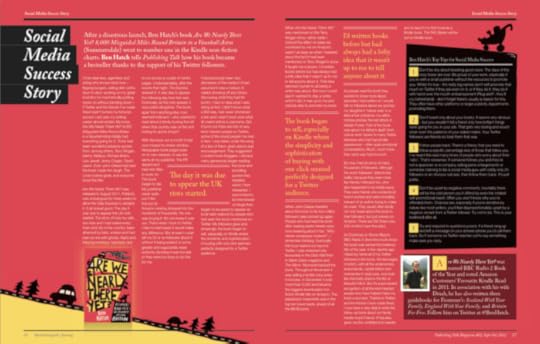
I’d be deal-less, agentless and doing who knows what now – flipping burgers, selling dish cloths door to door, working on my great invention for mechanically putting socks on without bending down – if Twitter and the friends I’ve made there hadn’t turned my fortunes around. In 2011 my writing career almost ended. My book Are We Nearly There Yet? A Family’s 8,000 Mile Car Journey Around Britain initially had everything going for it. There’d been wonderful advance quotes from, among others, Terry Wogan, Danny Wallace, Richard Briers, Lisa Jewell, Jenny Colgan, David Jason. Even John Cleese had said the book made him laugh. The cover looked great, everyone loved the title.
Are We Nearly There Yet? was released in August 2011. Publicity was embargoed for three weeks to allow the Daily Express to serialise it. It all looked good. The day it was due to appear the summer riots started. The story of how my wife, two kids and I had visited every town and city in the country, been attacked by bats, snakes and had had run-ins with ghosts, Nazis and thieving monkeys, had been due to run across a couple of centre pages. Understandably, after the events that night, The Express shelved it. It was due to appear the following day then the next. Eventually, as the riots spread, it was pulled altogether. The book, apart from anything else, now seemed irrelevant – who wanted to read about a family touring the UK when that country was on fire and looting its sports shops?
With the book out a month it had now missed its review window. Newspaper book pages were on to new releases. It was the same at my publisher. The PR department had new titles to work on. The book began to die. My publisher never quite put it like this but its Amazon ranking dropped into the hundreds of thousands. No-one was buying it. No-one knew it was out. That’s when I took to Twitter. I had no real hopes it would make any difference. But at least I could tell my 50 or so followers about it without it being subject to some greater and supposedly wiser authority deciding it was too late or they were too busy to do this for me.
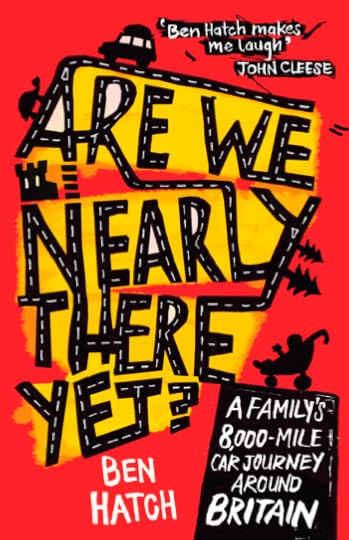 I’d previously been very dismissive of the medium (had assumed it was a mixture of celebs showing off and others discussing what they had for lunch). I’d no idea what I was doing at first. I didn’t know what a DM was, had never shortened a link and I wasn’t even sure what @ meant before a username. But it turns out there are lots of very kind, tolerant people on twitter; some of the nicest people I’ve met in fact. I was taken under the wing of a few of them; given advice and encouragement. They suggested I contact book bloggers. I did and many generously began reading the book and providing quotes they tweeted, which I then retweeted. I was invited to be interviewed on blogs then began to be asked to appear on local radio stations by people who’d seen the book mentioned on twitter. My followers grew and, amazingly, the book began to sell especially on kindle where the simplicity and sophistication of buying with one click seemed perfectly designed for a twitter audience.
I’d previously been very dismissive of the medium (had assumed it was a mixture of celebs showing off and others discussing what they had for lunch). I’d no idea what I was doing at first. I didn’t know what a DM was, had never shortened a link and I wasn’t even sure what @ meant before a username. But it turns out there are lots of very kind, tolerant people on twitter; some of the nicest people I’ve met in fact. I was taken under the wing of a few of them; given advice and encouragement. They suggested I contact book bloggers. I did and many generously began reading the book and providing quotes they tweeted, which I then retweeted. I was invited to be interviewed on blogs then began to be asked to appear on local radio stations by people who’d seen the book mentioned on twitter. My followers grew and, amazingly, the book began to sell especially on kindle where the simplicity and sophistication of buying with one click seemed perfectly designed for a twitter audience.
When Are We Nearly There Yet? was mentioned on the Terry Wogan show rather oddly I noticed the effect on sales (as monitored by me on Amazon) wasn’t as large as when I tweeted about the fact it had been mentioned on Terry Wogan’s show. It taught me a lesson. I’d written books before but had always had a lofty idea that it wasn’t up to me to tell anyone about it. That idea seemed counter to all being a writer was about. But now I could see if he wanted to stay a writer, which I did, it was up to me and nobody else to promote my book. When John Cleese tweeted about the book to his 2 million followers sales picked up again. People who’d read the book after reading earlier tweets were now tweeting about it too. Who needed newspaper reviews, I remember thinking. Eventually this buzz leaked out beyond Twitter. I was reviewed very favourably in the Daily Mail then in Marie Claire magazine and The Mirror. Mumsnet backed the book. Throughout November it was selling a kindle copy every 6 minutes. In December it sold more than 8000 and became the biggest downloaded non-fiction Kindle title on Amazon. The paperback meanwhile was in the top ten travel reads, ahead of all the Bill Brysons.
As people read the book they wanted to know more about episodes I’d written about. I’d talk to followers about our journey: my daughter’s “nature wee” in a field of live ordnance; my wife’s tortoise phobia; the bat attack in Kielder Forest. Part of the book was about my father’s death from cancer and I spoke to many on Twitter followers who’d had similar experiences; often quite emotional conversations. Much, much more than what was had for lunch.
 By now I had an army of many thousands of followers. Although the word followers distorts the reality because they were more like friends I followed too, who also happened to be media savvy. They were friends who understood how it worked and were incredibly tolerant of an author trying to make his mark. They’d often kindly not only tweet about the book to their followers, but put reviews on Amazon. There are 293 there now, 234 of which are five stars.
By now I had an army of many thousands of followers. Although the word followers distorts the reality because they were more like friends I followed too, who also happened to be media savvy. They were friends who understood how it worked and were incredibly tolerant of an author trying to make his mark. They’d often kindly not only tweet about the book to their followers, but put reviews on Amazon. There are 293 there now, 234 of which are five stars.
At Christmas on Simon Mayo’s Radio 2 drive-time book show the book was named the breakout title of the year. A few reprints ago I listed by name all of my Twitter followers in the book, the last pages of which, with all the underscores, ampersands, capital letters and nicknames in neat rows, now look like that batty shed in the film A Beautiful Mind. But it’s a permanent recognition of all the kind-hearted people who have helped make my book a success. Thanks to Twitter and the friends I have made there I now have a new deal to write the follow-up book about our family travels round France. It’s also given me the confidence to rewrite and relaunch my first novel, The P45 Diaries, as a Kindle book.
Ben Hatch’s Top Tips for Social Media Success
Don’t be shy about tweeting good news. The days of the ivory tower are over. Be proud of your work, especially if you’re with a small publisher without the resources to promote you. Whilst it’s true – the really big names don’t self-promote that much on Twitter if they are even on it, or if they do it, they do it with hand-over-the mouth embarrassment (“Plug alert!”, they’ll cry beforehand) – don’t forget there’s usually a reason for this. They often have other platforms or larger publicity departments promoting them.
Don’t tweet only about your books. It seems very obvious – but you wouldn’t tell a friend only how brilliant things were going for you in your job. That gets very boring and would strain even the patience of your oldest mates. Your Twitter followers are friends so treat them that way.
Follow people back. There’s a theory that you need to follow a specific percentage less of those that follow you. I’ve heard this said many times of people who worry about their ‘ratio’. That’s nonsense. If someone follows you and they’re not a spammer or a company selling penis enlargements or someone claiming to be a social media guru with oddly only 25 followers or an obvious nutcase, then follow them back. It’s just polite.
Don’t be upset by negative comments. Inevitably there will be the odd person you’ll offend by even the mildest self-promotional tweet. Often you won’t know why you’ve offended them. Chances are, especially if you’re sensitive by nature like most writers, you’ll feel disproportionately upset by a negative remark from a Twitter follower. Try not to be. This is your livelihood after all.
Try and respond to questions posed. If a friend rang up and left a message on your answer-phone you’d call them back. So if someone on twitter reaches out to say something make sure you reply.
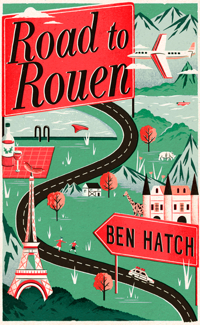 Ben Hatch’s new book Road to Rouen is out now.
Ben Hatch’s new book Road to Rouen is out now.


June 28, 2013
How a digital platform helped re-launch science fiction novel The Red Men
Dr. Easy , a short film by Shynola about a robot medic, is based on chapter one of The Red Men by Matthew De Abaitua. It stars Tom Hollander and had over 100,000 views in the first week of its release on Vimeo.
Cynics say that publishing a novel is like dropping a feather into the Grand Canyon. When I started out, I believed that good work would find its way in the end. Now I know it takes good work and something more.
My first novel The Red Men was published in 2007. I had spent six years planning, writing and re-writing The Red Men, trying to find a way to combine the point of view of literary fiction with the ideas and plotting of science fiction. To me, the future had arrived and I wanted to write a novel which expressed the terrifying quality of future shock that came with the first decade of the new century; a time of terrorist spectaculars, fear mongering, deluded economics, advanced technology and backward management.
I have no commercial nous. I have the kind of mind that rears away from common knowledge. If a million people are reading Dan Brown, then I am spared the trouble.
This approach has not made life easy for me.
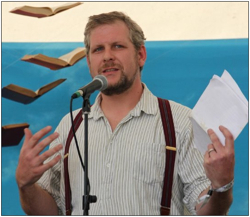 When it came to placing the book with an agent, I had already spent my twenties publishing short stories so I had a modest rep, a rep which cut no ice with the first few agents I approached. The Red Men aren’t very likeable characters, said one agent: no, I replied, they are deranged digital simulations of executives. And there the conversation ended.
When it came to placing the book with an agent, I had already spent my twenties publishing short stories so I had a modest rep, a rep which cut no ice with the first few agents I approached. The Red Men aren’t very likeable characters, said one agent: no, I replied, they are deranged digital simulations of executives. And there the conversation ended.
I was fortunate to catch the eye of Sarah Such, who was just starting up her own agency. She was ‘very taken’ with The Red Men. But first, she explained, the manuscript would need some work. For starters, it wasn’t called The Red Men; it was called Leave My Soul Alone. ‘Of course the title has to be changed,’ said Sarah. ‘And you should cut the swearing out. And you need a new opening that cues readers into what type of book this is.’ Over the next six months, I made the changes that Sarah requested and more.
The manuscript of The Red Men was acquired by James Bridle, who was then working at Snowbooks. James has since gone on to identify and curate the New Aesthetic; as a profile in Vanity Fair puts it, there is ‘a sensibility – uniquely British, it seems – that technology is not just something to make a billion from but something to prod and question.’ James Bridle asks these questions and so do The Red Men.
Come publication, there was a profile for the book on Bebo, and another on MySpace. A Second Life avatar reviewed the novel. I went to a warehouse in Sussex and signed a thousand copies for a promotion at Books Etc, and if you buy a copy of The Red Men from a second hand shop, it is likely to be one of them. Second Life? Bebo? Books Etc? Oh how redolent those words are of a bygone era.
Four months later the novel was short-listed for the Arthur C Clarke Award. The science fiction community left me in no doubt that I would not win. Assured that I would not be called upon to deliver any kind of speech, I set about efficiently and methodically getting drunk.
Normally, that would be the end of the story of my first novel. Except. Except. Except.
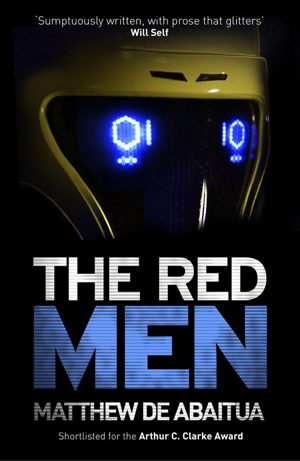 Just before The Red Men was published, I had lunch with a friend who mentioned that Shynola, a highly regarded collective who had made music videos for the likes of Radiohead, were trying to come up with an idea that could launch their film career. I first came across Shynola when they put together an amazing title sequence for a very low budget documentary series called SF:UK that I wrote and presented for Channel 4. Their work was the best thing about it.
Just before The Red Men was published, I had lunch with a friend who mentioned that Shynola, a highly regarded collective who had made music videos for the likes of Radiohead, were trying to come up with an idea that could launch their film career. I first came across Shynola when they put together an amazing title sequence for a very low budget documentary series called SF:UK that I wrote and presented for Channel 4. Their work was the best thing about it.
‘They should take a look at my novel,’ I said. My thought process went like this: I’ve written a science fiction novel set in Hackney. Shynola live in Hackney and like science fiction. As my agent says, you have to find people who understand and love your book, and build from there.
Sarah sent them a copy. They liked it and decided that The Red Men would be their first film, optioning the film rights before the book was even published It was the beginning of a six-year journey. Shynola later took their script to Warp Films, who in turn took it to Film4.
Ebooks were a mere rumour in 2007, and so The Red Men did not go digital when it was first published. With renewed interest ahead of the release of Dr Easy, my agent took the e-book rights to Gollancz. I am a big fan of the Gollancz SF Masterworks list, and consider them the pre-eminent publisher of science fiction. It’s an honour to fly under their flag and Gollancz were able to publish quickly to coincide with the worldwide launch of the film.
Prior to ebook publication in 2013, I decided to give the manuscript a quick going over. I’ve written about the process in more depth at Hilobrow, concerning questions such as simplifying the novel’s point-of-view and massacring my various darlings. The writing that leaves your desk should be in the finest condition possible. For the re-edited The Red Men, I sneakily tweaked some of the novel’s tech to take account of recent advances. Rewriting is the fun part of writing.
In June, Dr Easy, a short film written by Shynola starring Tom Hollander and based on the first chapter of The Red Men was released by Film4 and Warp Films onto video streaming site Vimeo, having premiered the day before at Edinburgh International Film Festival 2013 It is worth noting that this first chapter was the one I had added to the book on the advice of my agent.
In less than a week, Dr Easy racked up an astonishing 100,000 plays and has been recommended on Twitter by everyone from Trent Reznor to Adam Buxton. The release of Dr Easy thus coincided with the first publication of a revised edition of The Red Men ebook by Gollancz, which entered the Amazon Top 100 for science fiction.

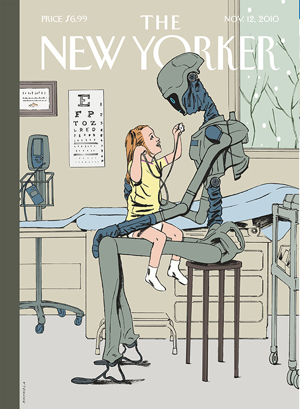 I teach writing science fiction at the University of Essex. One of the assignments I give is world-building; it is a chance for the students to expand their invented world without troubling with narrative. As Shynola proceed with their adaptation of The Red Men, they have been expanding upon the world of the novel. The corporate entity in the novel Monad now has its own website which lays out their main product lines (Red Men, Dr Easy, Red Town) and has some beautiful magazine covers from around the launch of medical robots. Shynola are also assembling an online mood-board for the adaptation at www.theredmenmovie.com, and many of the images are drawn from the same area as James Bridle’s New Aesthetic, all of which is inspiring my next novel IF THEN, which am I deeply enmeshed in completing.
I teach writing science fiction at the University of Essex. One of the assignments I give is world-building; it is a chance for the students to expand their invented world without troubling with narrative. As Shynola proceed with their adaptation of The Red Men, they have been expanding upon the world of the novel. The corporate entity in the novel Monad now has its own website which lays out their main product lines (Red Men, Dr Easy, Red Town) and has some beautiful magazine covers from around the launch of medical robots. Shynola are also assembling an online mood-board for the adaptation at www.theredmenmovie.com, and many of the images are drawn from the same area as James Bridle’s New Aesthetic, all of which is inspiring my next novel IF THEN, which am I deeply enmeshed in completing.
What is the moral of this story? What can be learnt from it? Over the years, The Red Men has gained traction because it anticipated the way social media and the network would reconfigure our humanity. But back in 2007, as they say in business, being early was the same as being wrong.
I have come through this experience with the understanding that good work is only the start of the process. A writer needs to be supported for several years by the right people otherwise their work can disappear very quickly. Agents and editors, writers and publishers alike should support talented people who have the desire and hard-won skills to do good work, and who will not stint on the effort and discipline required to implement their ideas. This seems obvious but it is also very rare, and I’ve been fortunate in the people I’ve worked with
The Red Men ebook is published by Gollancz and available from Amazon.co.uk, iTunes and Google Play.


June 14, 2013
Room to Write – Liz Fenwick finds inspiration for romantic fiction in Cornwall
This article originally appeared in Publishing Talk Magazine issue 4.
Not all romantic novelists dictate their novels reclining on a chaise longue. Liz Fenwick tells us where she writes – and finds inspiration.

When I say I’m a novelist, a romantic novelist, everyone automatically thinks of Dame Barbara Cartland dressed in pink and dictating her novels while lying on a chaise longue eating bonbons. Life should be so good – or maybe it’s what I should aspire to – but the reality is that writing for me happens everywhere.
I began writing romantic fiction when my kids where young and I wrote during school hours in a quiet corner of my bedroom. This worked most of the time and I learnt that I could even write while sitting at the kitchen table while they were doing homework. It became a bit tricky though if I had to write a sex scene and the six-year-old began reading over my shoulder…
At the moment my life is divided between Dubai, London and Cornwall, so I don’t have one special writing space. This crazy existence has destroyed any hope of a set routine. But thanks to the early days of writing with small children around I have learned to write when time permits and can write anywhere.
My physical location as I write is immaterial. What is happening in my head is the important thing and not what is going on around me. In fact, I do some of best writing while stuck at 30,000 feet with no Internet to lure me away from the task at hand.
I write the first draft of my novels in a fast and furious manner on my laptop. The need to get the story down and discover what my characters are made of drive the crazy rush. But in subsequent drafts I spend time writing out key scenes in long hand to use a different side of my brain. This is really important for the descriptive passages where I want to convey the essence of Cornwall as I see it.
As novelists we create worlds for our readers and for me I have to create a bubble around myself when I’m working that holds me in Cornwall. So, sitting in the desert of Dubai, I find I spend an awful lot of the time in the rain of Cornish countryside. I may be looking out at the bougainvillea in the garden but thinking of foxgloves in the hedges.
However, I do my best work while seated in my kitchen at our home in Cornwall. Instead of working at the dining room table in Dubai where I can only imagine the beauty of Cornwall, in my Cornish kitchen I can glance away from the screen and see it. I love stealing down in the early hours of the morning before the family wakes. With a strong cup of coffee, I can enjoy the peace of the morning to work and can look up to see the golden rays of the sunrise creep into the garden to transform the colour from dull to vivid.
So the short answer to where do I write is in Cornwall either virtually or actually. Maybe I should add the chaise longue and bonbons… to the virtual part at least!
 Liz Fenwick’s new novel A Cornish Affair is published by Orion and available now from Amazon.com or Amazon.co.uk.
Liz Fenwick’s new novel A Cornish Affair is published by Orion and available now from Amazon.com or Amazon.co.uk.
See more writing rooms on the Publishing Talk Pinterest board.


Room to Write – Liz Fenwick
This article originally appeared in Publishing Talk Magazine issue 4.
Not all romantic novelists dictate their novels reclining on a chaise longue. Liz Fenwick tells us where she writes – and finds inspiration.

When I say I’m a novelist, a romantic novelist, everyone automatically thinks of Dame Barbara Cartland dressed in pink and dictating her novels while lying on a chaise longue eating bonbons. Life should be so good – or maybe it’s what I should aspire to – but the reality is that writing for me happens everywhere.
I began writing romantic fiction when my kids where young and I wrote during school hours in a quiet corner of my bedroom. This worked most of the time and I learnt that I could even write while sitting at the kitchen table while they were doing homework. It became a bit tricky though if I had to write a sex scene and the six-year-old began reading over my shoulder…
At the moment my life is divided between Dubai, London and Cornwall, so I don’t have one special writing space. This crazy existence has destroyed any hope of a set routine. But thanks to the early days of writing with small children around I have learned to write when time permits and can write anywhere.
My physical location as I write is immaterial. What is happening in my head is the important thing and not what is going on around me. In fact, I do some of best writing while stuck at 30,000 feet with no Internet to lure me away from the task at hand.
I write the first draft of my novels in a fast and furious manner on my laptop. The need to get the story down and discover what my characters are made of drive the crazy rush. But in subsequent drafts I spend time writing out key scenes in long hand to use a different side of my brain. This is really important for the descriptive passages where I want to convey the essence of Cornwall as I see it.
As novelists we create worlds for our readers and for me I have to create a bubble around myself when I’m working that holds me in Cornwall. So, sitting in the desert of Dubai, I find I spend an awful lot of the time in the rain of Cornish countryside. I may be looking out at the bougainvillea in the garden but thinking of foxgloves in the hedges.
However, I do my best work while seated in my kitchen at our home in Cornwall. Instead of working at the dining room table in Dubai where I can only imagine the beauty of Cornwall, in my Cornish kitchen I can glance away from the screen and see it. I love stealing down in the early hours of the morning before the family wakes. With a strong cup of coffee, I can enjoy the peace of the morning to work and can look up to see the golden rays of the sunrise creep into the garden to transform the colour from dull to vivid.
So the short answer to where do I write is in Cornwall either virtually or actually. Maybe I should add the chaise longue and bonbons… to the virtual part at least!
 Liz Fenwick’s new novel A Cornish Affair is published by Orion and available now from Amazon.com or Amazon.co.uk.
Liz Fenwick’s new novel A Cornish Affair is published by Orion and available now from Amazon.com or Amazon.co.uk.
See more writing rooms on the Publishing Talk Pinterest board.





